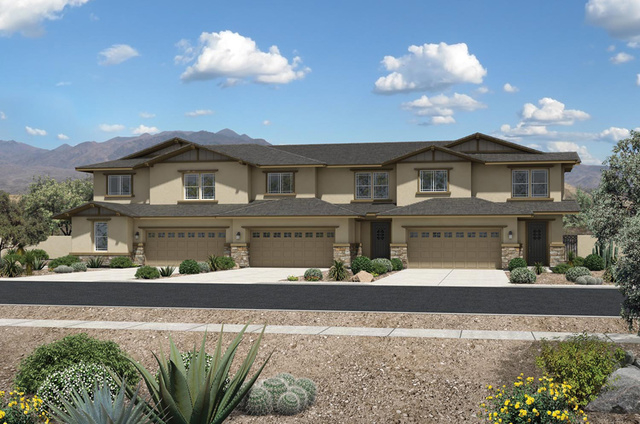New-home market seen underperforming in ‘14, ‘15
Two years of recovery in the local housing market won’t keep Southern Nevada’s new-homes segment from underperforming in 2014.
And local housing and economic experts said Friday at Home Builders Research’s Housing Outlook, at the Springs Preserve, that the market should expect more of the same in 2015.
They blamed a wide range of factors, including a slower permitting process, increasing prices, rising competition from resales and new federal mortgage-lending guidelines.
To understand how 2015 might shake out, look first at what has happened in 2014.
Dennis Smith of Home Builders Research had forecasted 7,000 new-home closings for the year, but that number will likelier end up at around 6,250 sales — a 14.4 percent drop from 2013’s 7,303 closings. Units sold per month have slumped from a 2013 peak of 763 to around 600 now; those numbers may edge down even more with a seasonal slowdown through year’s end, Smith said.
Nor will sales pick up much in 2015. Smith predicted 6,500 closings then, despite there being enough demand for as many as 7,800 new units.
The number of closings moves in lockstep with permits issued by local municipalities. And that statistic has tumbled over the last decade. New-home permits hit a high of nearly 33,000 in 2004, and plummeted to around 3,700 in 2011. They’ve recovered to about 7,000 a year since 2013. That’s below what the market could bear, Smith said. Twenty to 25 years ago, when the Las Vegas Valley had fewer than half of the 2 million residents it has now, builders pulled 10,000 to 12,000 permits a year.
So why have permits stayed relatively low?
Smith blamed Clark County’s new-homes permitting process. A mapping procedure that used to take six to seven months now takes 10 to 11, he said.
Permitting agencies in Las Vegas, Henderson and North Las Vegas aren’t seeing the same delays, Smith said, but because Clark County accounts for 50 percent to 60 percent of local permits pulled, any delays there have a broad effect on the market.
County officials said in a Friday statement that they’re aware of the issue and working on it.
“During the downturn in the housing market and the overall economy, the county had to eliminate staff as the work significantly declined,” the statement read. “Now that the housing market is improving, many in the housing industry believe our services should perform at the pre-recession level. We are concerned with the review times and have been adding staff as the strength of the market continues to improve.”
Smith said short staffing “is a pretty easy answer” to why permitting takes longer.
“But you’re delaying four, five or six months of closings,” he said. “Every new home accounts for a little over three jobs, plus the taxes it brings into their coffers. I would think they would want the market to close on the homes sold. Something’s got to be done there. You’ve got to speak up, because those delays are costing us permits and closings.”
The shortage of permits isn’t the only thing quelling the market, other panelists said.
New-home prices are on the rise, hitting a local median of $299,601 in September. Expect more gains in 2015, as prices edge up 4 percent to 6 percent, Smith said.
That median price may be taking its toll. Panelist Alex Barron, founder of the Texas-based Housing Research Center, said model-home traffic is “down pretty sharply” in recent weeks in markets in Nevada, Texas and Colorado. Some subdivisions report as few as five shoppers a week, compared with a norm of 15 to 20 per week.
That could partly be because people are looking more at resales. Resale listings are increasing, and the inventory is of a higher quality today than it was when abandoned and stripped foreclosures ruled the market a few years ago. That means more competition for new-home builders.
“The (price) differential between new and existing homes is huge, and builders keep pushing prices every month,” Barron said. “The biggest complaint I hear from salespeople is that they feel a lot of people can’t afford these homes anymore. The reason sales are at such a low level is, how many people can afford a $300,000 or $400,000 home? We need to find a way to build a cheaper home.”
That could be difficult, said panelist John McLaurey, vice president of sales and marketing for KB Home Nevada.
“Let’s face it, the price we’re charging for homes is a function of the market,” McLaurey said. “Our costs have been going up. Land costs have been going up. There’s not a builder out there artificially increasing prices. We’re a for-profit business. We have to make a profit. Given where land and indirect costs have gone, we’ve got to push prices.”
Beyond prices, changing federal lending rules have “hurt” builders, McLaurey said. The Federal National Mortgage Association, or Fannie Mae, said in August that it would require consumers getting its loans to wait four years after a short sale or foreclosure before borrowing again. Guidelines formerly mandated a two-year waiting period.
And the housing administration in January dramatically lowered the size of the mortgage it would guarantee in Las Vegas. The agency cut allowed loan amounts 31 percent, from $417,000 to $287,500.
The agency is weighing lowering down-payment requirements to help some homeowners qualify, Barron said, but the better option might be to ease up on rigid credit-score rules.
Until factors curbing the market abate, builders will have to get creative, McLaurey said.
“We try to develop an innovative product based on what consumers are looking for. We have to find a happy medium — a balance between price and innovation, and we have to work to differentiate ourselves from the competition. You need a unique selling proposition to get people excited about buying a new home.”
Contact Jennifer Robison at jrobison@reviewjournal.com. Find her on Twitter: @J_Robison1






















